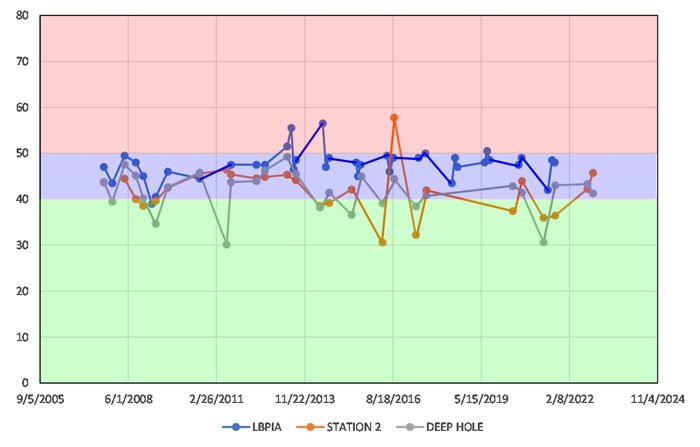Lake Beulah Water Quality Dashboard
HEALTH OF LAKE BEULAH: KEEP LAKE BEULAH BLUE
Current status: Blue (which is healthy and good) as of August 2024
One of the values used to measure the health of a lake is the Trophic State Index (TSI). TSI is a method to numerically measure the productivity and health of a lake.
Over many years of surface water studies, the aquatic biology community came up with the “trophic state index,” as a way to evaluate the environmental health of a lake or stream. Although many chemical parameters are monitored in lake water, this evaluation uses the indicator parameters of clarity (Secchi disk), phosphorus and chlorophyll-a. Because these are not co-dependent parameters, correction factors were empirically derived such that they can all be plotted on graphs with identical ranges (0 to 80), indicating the environmental health of a water body, classified as oligotrophic, mesotrophic or eutrophic. The conditions that are indicative of oligotrophic occupies half of the scale, ranging from 0 to 40. Mesotrophic, which is the desired state, makes up only 10 points in the scale, from 40 to 50. Eutrophic values range from 50-80.
Water Quality Data from summer of 2024 shows Lake Beulah remains a Mesotrophic Lake with high-quality water. The water is moderately clear, exhibits low dissolved oxygen in deep water during the summer. 2024 samples TSI(TP) > TSI(Chl) = TSI(Sec) total phosphorus (47.4) chlorophyll-α (46.5) Secchi value (45.5) results suggest zooplankton grazing, nitrogen or some factor other than phosphorus is limiting algae biomass according to WDNR website for Lake Beulah. 2023 values were as follows: total phosphorus (48.5) chlorophyll-α (43.6) Secchi value (42.1).
The button below will take you to the WDNR Water Quality Website for Lake Beulah. It shows up-to-date data, as well as historical data.
GRAPH OF TSI COLLECTION DATA
Color Key:
Green (eutrophic): too many nutrients
Blue (mesotrophic): good level of nutrients
Red (oligotrophic): low nutrients/sterile
Date of Collection: 5/22/22
Source: WI Department of Natural Resources
Collected by: PLB
HOW CAN YOU KEEP LAKE BEULAH BLUE
Dos:
1. Reduce the flow of runoff into the lake, which decreases flow of pollutants and soil into the lake. Reducing the flow of runoff is especially important if your property has a steep slope to the lake.
2. Maintain your septic systems on a regular basis to avoid lake contamination.
3. Check all home cleansing products to make sure they say “phosphate free”.
4. Plant native species along the shoreline to provide habitat and food for fish and insects and prevent erosion. View this Homeowners Guide to Native Shoreline Gardens.
5. Use low phosphate, slow release nitrogen fertilizer on vegetated areas from 30-250 feet of the shoreline.
6. Travel slowly in shallow lake areas to avoid churning up the lake bottom sediments, which will decrease algae and cyanobacteria growth.
Don’ts:
1. Bathe, shampoo, or wash boats, pets, or other objects in the lake.
2. Use any fertilizer or herbicide within 30 feet of the shoreline.
3. Burn brush or leaves or dump yard clippings on the ice or water near the shoreline. They add nutrients to the water, which will increase algae growth.
4. Feed ducks or other aquatic organisms. Nutrients produced from unnatural food outside the lake’s watershed, will be added to the lake through the organism’s feces.
Water Testing
The lake quality is considered: GOOD.
One measure of a lakes health is the trophic state, which relates to the amount of algae in the water. The average summer trophic state for the last 5 years was 45 (Mesotrophic) and was determined using chlorophyll data. For a “Two-Story” lake, this is considered Good.
Mesotrophic - Mesotrophic lakes are characterized by moderately clear water but have an increasing chance of low dissolved oxygen in deep water during the summer.
Lake Beulah has been monitored by volunteers since 1991. Volunteers monitor water clarity with a black and white Secchi disk. Some also collect water samples, which are sent to the State Lab of Hygiene to be analyzed. Volunteers are the source of the majority of Wisconsin's lake water quality data, and their dedication is greatly appreciated. Additional monitoring has been done through projects funded in part by DNR Lake Grants and Aquatic Invasive Species Grants. Reports and graphs featuring data collected by volunteers, DNR staff and others can be viewed below.
SECCHI TESTING
Every year, volunteers collect water samples using Secchi Disk readings from lakes in Wisconsin. This data is calibrated with a mathematical model and satellite imagery to achieve the most accurate readings of water quality on over 8000 lakes in the state.
The Wisconsin DNR uses data from both the Landsat 5 and Landsat 7 satellites; volunteers schedule their testings based on the day that the satellite passes overhead.
Check out this Wisconsin Citizen Lake Monitoring Training Manual (PDF pages 26-28) to see the 13 Steps that PLB Board Member Kim Rosenmayer takes to monitor the water clarity of Lake Beulah.
Questions? Contact Kim Rosenmayer



